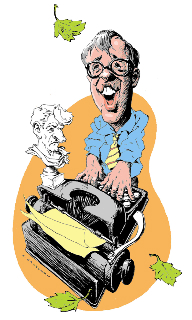Harth-Bedoya photo by Christian SteinerSERGEI PROKOFIEV’S FIFTH SYMPHONY dates from 1944, but it is the latest large-scale orchestral work to achieve permanence in the standard repertory. Some two dozen recordings are listed in the latest Schwann; at least that many more have come and gone. Until the performance at the Hollywood Bowl a couple of weeks ago, with the visiting Russian National Orchestra under its associate conductor, Andrey Boreyko, I don’t think I’d ever heard the work set forth with its emotional proportions as well balanced, its range of color so handsomely preserved.
It’s a big, tricky work, running 40 minutes more or less. Its two fast movements have the ring of the familiar Prokofiev: the sassy sudden jumps from one key to somewhere in the middle of next week, the glistening orchestration with its insolent brassy blats, and, in the middle of the scherzo, the wailing tune — inane but delicious — that suggests a visit from Boris Godunov‘s Fool. The slow movements — the first and third — play the most tricks; they start off with long, sweeping tunes which then turn bitter. Boreyko’s reading with the Russians underlined the truly mean-tempered, sardonic qualities in the first movement that I had somehow failed to notice in perhaps half-a-hundred previous hearings. And he delivered the third movement, which others have made sentimental and trivial, in a dry-eyed manner that restored this splendid music to its rightful place as the emotional crown of the entire work.
As the hordes of Russian orchestras come a-calling to garner a few dollars, it becomes harder to tell them apart. Despite its name, the Russian National is privately, not governmentally, supported; it was founded in 1990 by the much-admired pianist and conductor Mikhail Pletnev. He, however, suffered a foot injury while hiking just before his Bowl engagement, and therefore turned over the Bowl concerts to his two assistants. I missed the first, Dmitri Liss; Boreyko’s program had the more substantial music. Even from what I could tell from the Bowl’s sound system — which has been unusually iffy all summer — this is a remarkably sleek ensemble, deep and resonant in the way we always think of as “Russian.” They employ the classic seating, with first and second violins downstage; even through microphones, it makes the difference of a brighter string tone. The difference was even more audible in Beethoven’s Egmont Overture and Third Piano Concerto, although the latter was marred by the solo performance — most kindly described as doddering — by Vitaly Margulis, who is actually a local resident and on the UCLA piano faculty but who has never, for reasons not beyond deciphering, previously performed at the Bowl. (Has Russia suddenly run out of pianists?) Better yet, conductor and players went through an elaborate tune-up procedure before the concert, section by section — standard operating procedure with this orchestra, I am told. That, too, made a highly audible difference.
BACK IN PLACE AFTER A WEEK OFF, THE Philharmonic also placed itself in the hands of its assistant conductors last week, and I placed my ears in the hands of Andrew Robinson for an evening of Italian stuff with singers, and Miguel Harth-Bedoya for Latin diversions far more diverting. Harth-Bedoya, by the way, has just been upgraded to associate conductor and, from last week’s evidence, deserves the promotion.
The peculiar appeal of Alessandra Marc continues to elude me. Among a certain clique of opera fanatics she is the reigning Sacred Monster, and the grotesqueness of her appearance onstage (think docking supertanker) adds to her brownie points in that regard. But in achieving her current — er — stature, she has wasted, it seems to me, a precious resource. The incompatibility of stunning vocal equipment and utter carelessness in its use — notes bumped, breath out of control, passage work blurred and edgy — has to rank as a major tragedy. That evening at the Bowl, she sailed with mighty sound-blasts through the notes of Cilea, Puccini and Verdi, but never the music. In a Tosca duet, the excellent Mexican tenor Fernando de la Mora seemed anxious (and well-qualified) to help her shape her volcano of sound into something identifiable as melody, but to little avail. Nor did Andrew Robinson’s conducting — oddly enough, both flaccid and unyielding — help much, in the vocal selections or, on his own, in the lurid poster art of Respighi’s The Pines of Rome. He also needs some training in podium manners; no matter how rotten your soloist may be, you have to hug, shake hands or otherwise acknowledge her presence after the performance.
The program at Friday’s “Latin Spectac-ular” was lighter in weight, but not by much. Astor Piazzolla’s Bandonéon Concerto is a subtle, complex work full of deep undercurrents, wonderfully laid out for the plangent, throbbing solo instrument and nicely set against the small orchestra. Argentina’s Horacio Romo delivered the captivating, insinuating music with his own brand of mastery.
Fernando de la Mora was back for a varied collection of Latino ballads, not all of them the castañas of the repertory. I like his voice, clear and ringing; more than one other singer in the land could profitably study his clean, unforced delivery, and the lack of the affectations — the sobs, the gargles — that some find necessary to put over simple, ingratiating melodic material. Young (31) Harth-Bedoya, Peruvian-born and also recently appointed conductor of the Eugene Symphony, led the proceedings with zip and, one might assume, pride; he also chatted up the audience between numbers, just possibly to excess. Oh, how I wish that musical hosts given to verbal program notes could retire the “journey” metaphor for a year, or two. Or 10.


